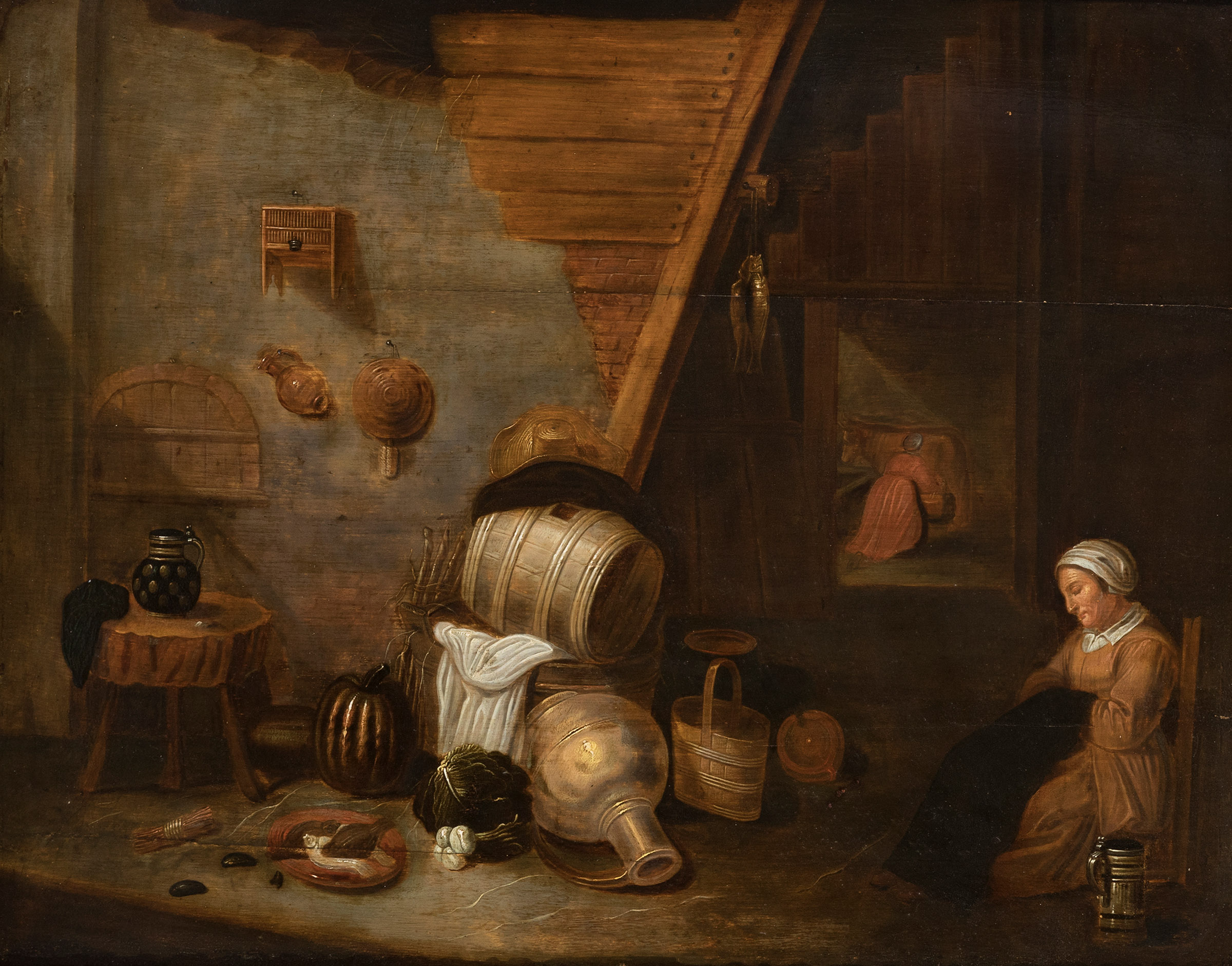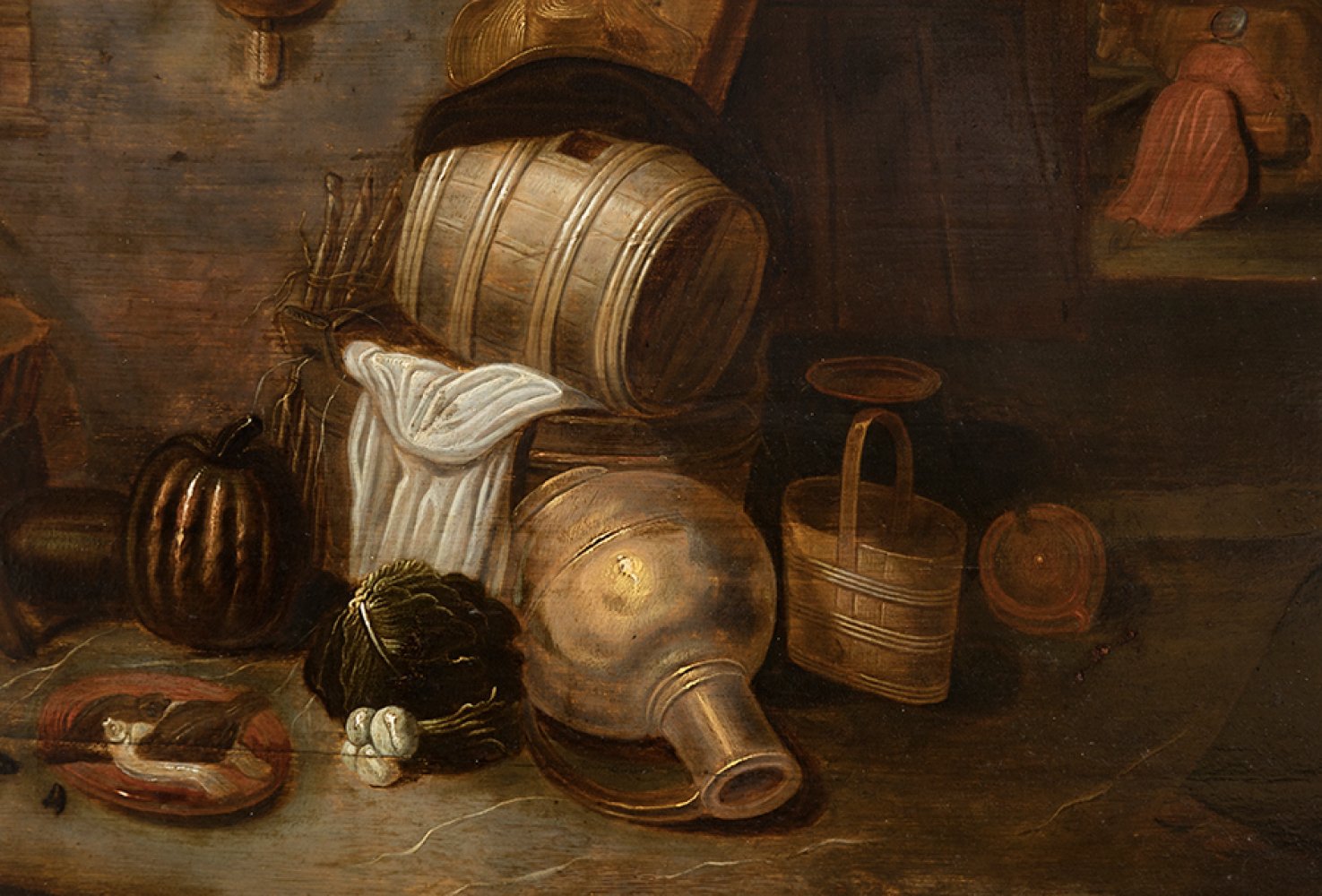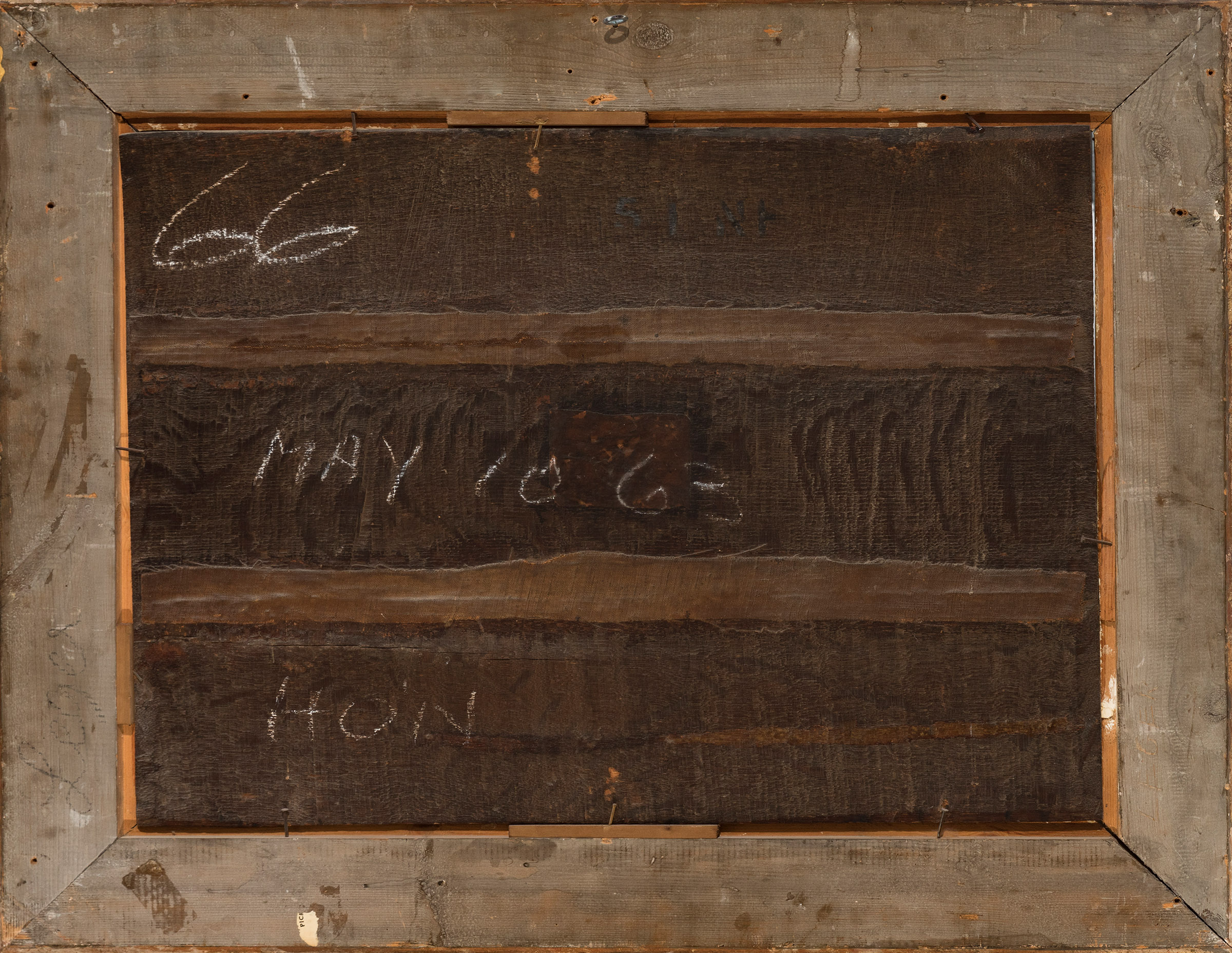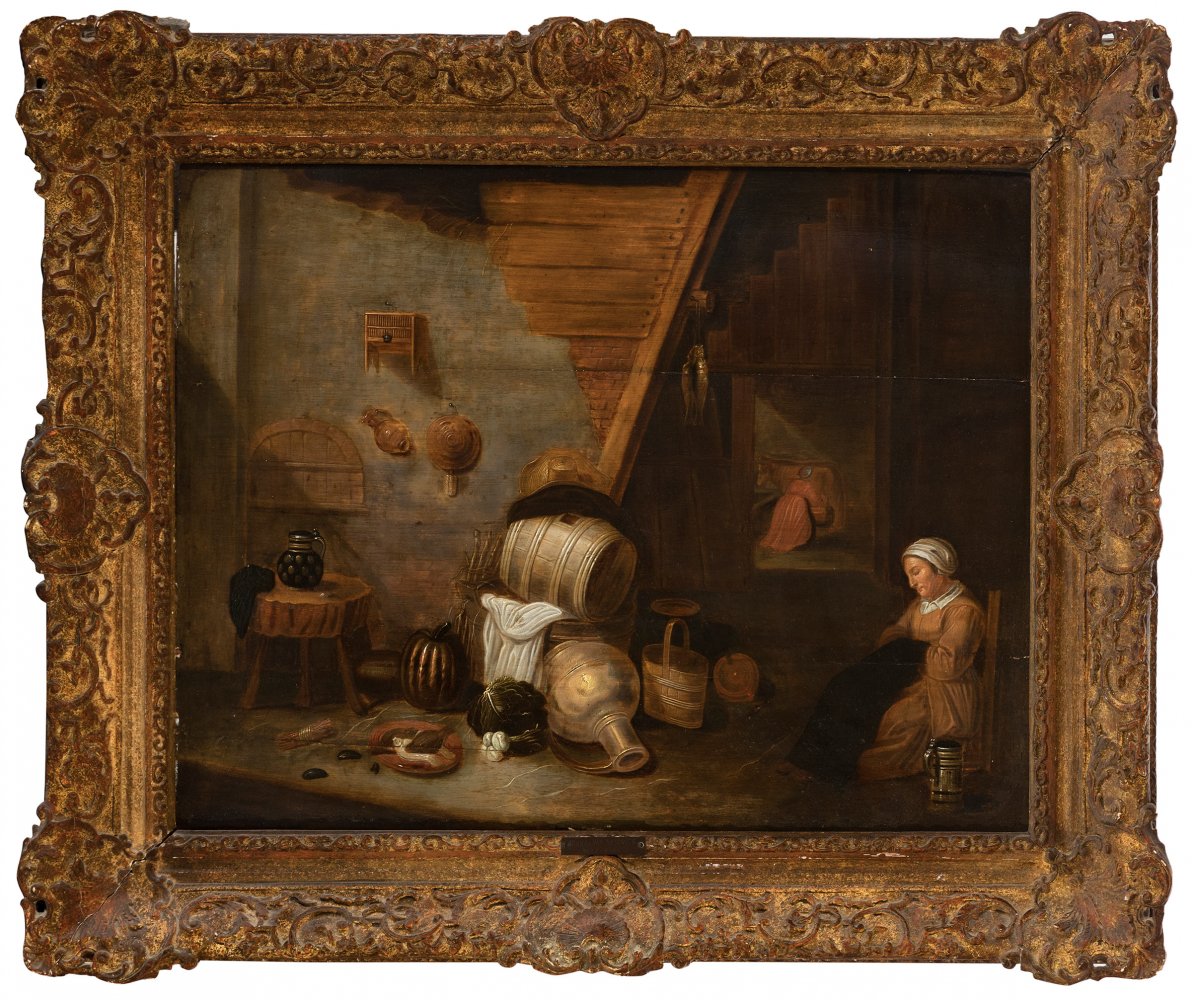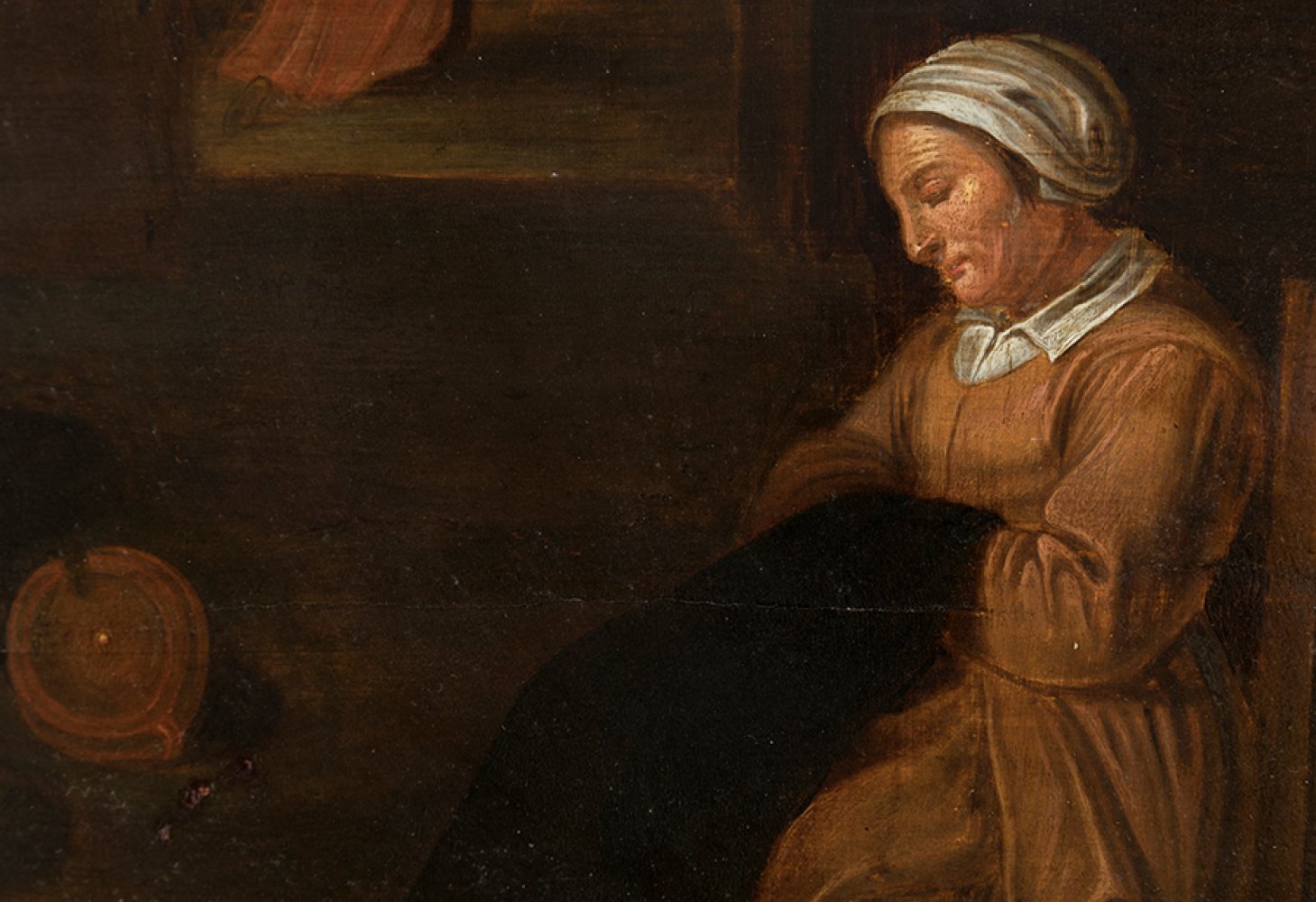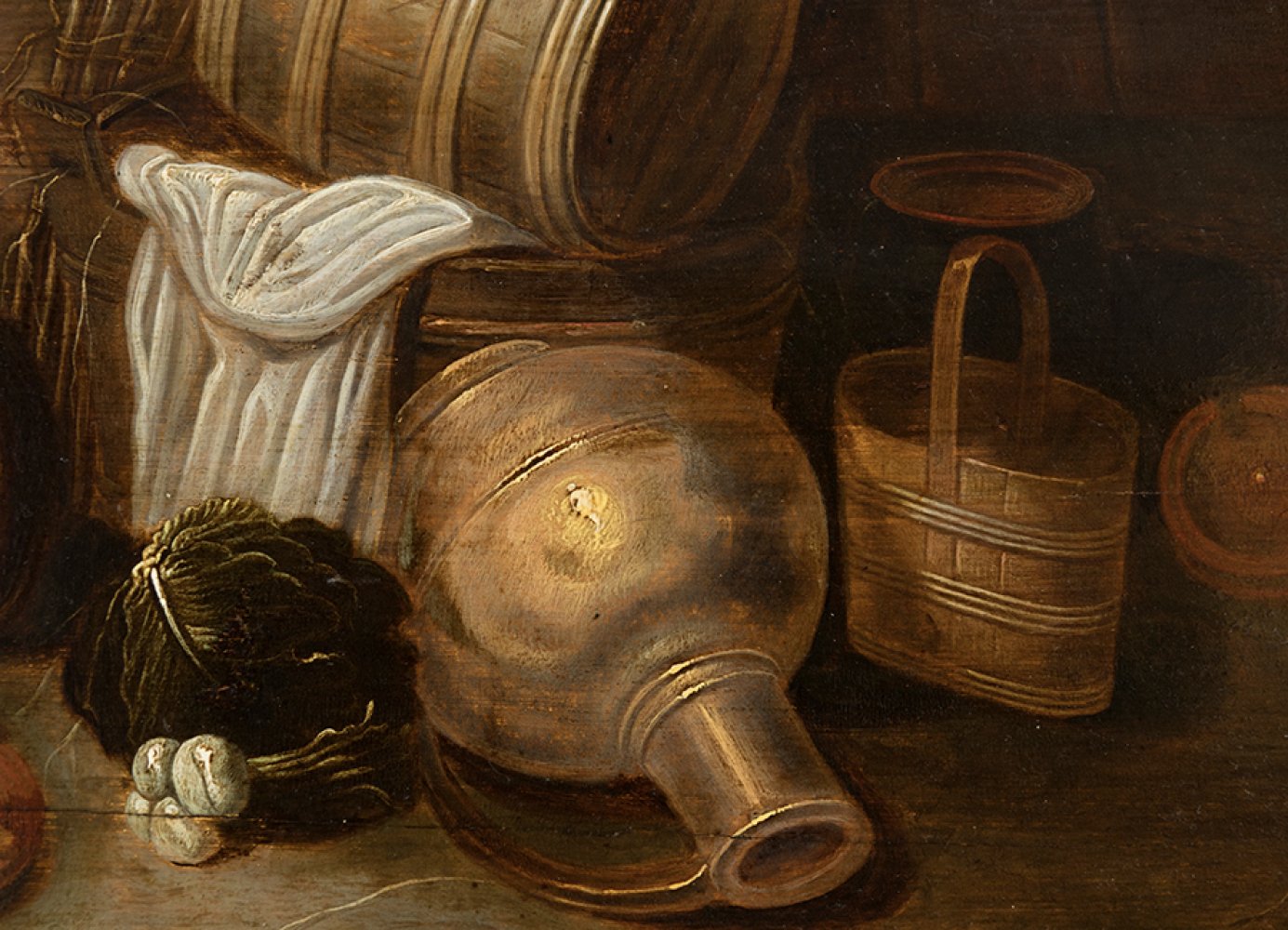7
Dutch school; 17th century."Still life in the kitchen".Oil on oak panel.The panel is open and
"Still life in the kitchen".
Oil on oak panel.
The panel is open and consolidated.
It has a 19th century frame with slight faults.
Measurements: 48 x 64,5 cm; 67 x 84 cm (frame).
In this work the author captures an interior scene, in which a woman seated in the right zone of the scene is immersed in her tasks, while in the last plane another lady can be seen with her back to the spectator. The painting belongs to the aesthetic trend of depicting customs, one of the genres that enjoyed the greatest development in the Dutch Baroque school. Thus, the space is clearly defined and minutely depicted, and the figures are depicted at a large size. Both the two figures and the cow on the left of the composition are large. However, they are rivalled in prominence by the group of objects distributed over the entire surface, which are depicted as an independent still life.
It was undoubtedly in the paintings of the Dutch school that the consequences of the political emancipation of the region and the economic prosperity of the liberal bourgeoisie were most evident. The combination of the discovery of nature, objective observation, the study of the concrete, the appreciation of the everyday, the taste for the real and the material, the sensitivity to the apparently insignificant, meant that the Dutch artist was at one with the reality of everyday life, without seeking any ideal that was alien to that same reality. The painter did not seek to transcend the present and the materiality of objective nature or to escape from tangible reality, but to envelop himself in it, to become intoxicated by it through the triumph of realism, a realism of pure illusory fiction, achieved thanks to a perfect, masterly technique and a conceptual subtlety in the lyrical treatment of light. As a result of the break with Rome and the iconoclastic tendency of the Reformed Church, paintings with religious themes were eventually eliminated as a decorative complement with a devotional purpose, and mythological stories lost their heroic and sensual tone in accordance with the new society. Thus portraiture, landscape and animals, still life and genre painting were the thematic formulas that became valuable in their own right and, as objects of domestic furnishings - hence the small size of the paintings - were acquired by individuals from almost all social classes and classes of society.During the 17th century various influences, mainly thematic, arrived in Holland from Flanders. Within the Flemish school at this time there was a high degree of specialisation among painters, focusing on still-life subjects, architecture, genre paintings, etc. Within this latter range of subjects, particularly notable were the tavern scenes depicted by Adriaen Brouwer and David Teniers the Younger, both from the first half of the 17th century. The success of this type of scene was deeply rooted in the Dutch Baroque school, dominated by the figures of Rembrandt and Hals. Dutch painters such as Vermeer and Pieter de Hooch focused on genre subjects, but mainly depicted scenes of the intimacy of the upper classes. On the other hand, certain authors looked to the works of Brouwer and Teniers to establish a different genre, taking the village as their model. Over time, the genre evolved independently in the Netherlands, moving away from the dark, warm and restrained chromatic settings typical of Flanders. Thus, in the present work, which dates from the early 18th century, a foreground in the semi-darkness is illuminated by a bright light, which draws silver glints from the objects around the table, arranged as if in a still life, and captured with the same attention to detail and the depiction of quality.
"Still life in the kitchen".
Oil on oak panel.
The panel is open and consolidated.
It has a 19th century frame with slight faults.
Measurements: 48 x 64,5 cm; 67 x 84 cm (frame).
In this work the author captures an interior scene, in which a woman seated in the right zone of the scene is immersed in her tasks, while in the last plane another lady can be seen with her back to the spectator. The painting belongs to the aesthetic trend of depicting customs, one of the genres that enjoyed the greatest development in the Dutch Baroque school. Thus, the space is clearly defined and minutely depicted, and the figures are depicted at a large size. Both the two figures and the cow on the left of the composition are large. However, they are rivalled in prominence by the group of objects distributed over the entire surface, which are depicted as an independent still life.
It was undoubtedly in the paintings of the Dutch school that the consequences of the political emancipation of the region and the economic prosperity of the liberal bourgeoisie were most evident. The combination of the discovery of nature, objective observation, the study of the concrete, the appreciation of the everyday, the taste for the real and the material, the sensitivity to the apparently insignificant, meant that the Dutch artist was at one with the reality of everyday life, without seeking any ideal that was alien to that same reality. The painter did not seek to transcend the present and the materiality of objective nature or to escape from tangible reality, but to envelop himself in it, to become intoxicated by it through the triumph of realism, a realism of pure illusory fiction, achieved thanks to a perfect, masterly technique and a conceptual subtlety in the lyrical treatment of light. As a result of the break with Rome and the iconoclastic tendency of the Reformed Church, paintings with religious themes were eventually eliminated as a decorative complement with a devotional purpose, and mythological stories lost their heroic and sensual tone in accordance with the new society. Thus portraiture, landscape and animals, still life and genre painting were the thematic formulas that became valuable in their own right and, as objects of domestic furnishings - hence the small size of the paintings - were acquired by individuals from almost all social classes and classes of society.During the 17th century various influences, mainly thematic, arrived in Holland from Flanders. Within the Flemish school at this time there was a high degree of specialisation among painters, focusing on still-life subjects, architecture, genre paintings, etc. Within this latter range of subjects, particularly notable were the tavern scenes depicted by Adriaen Brouwer and David Teniers the Younger, both from the first half of the 17th century. The success of this type of scene was deeply rooted in the Dutch Baroque school, dominated by the figures of Rembrandt and Hals. Dutch painters such as Vermeer and Pieter de Hooch focused on genre subjects, but mainly depicted scenes of the intimacy of the upper classes. On the other hand, certain authors looked to the works of Brouwer and Teniers to establish a different genre, taking the village as their model. Over time, the genre evolved independently in the Netherlands, moving away from the dark, warm and restrained chromatic settings typical of Flanders. Thus, in the present work, which dates from the early 18th century, a foreground in the semi-darkness is illuminated by a bright light, which draws silver glints from the objects around the table, arranged as if in a still life, and captured with the same attention to detail and the depiction of quality.
7th September - Old Masters
Sale Date(s)
Venue Address
General delivery information available from the auctioneer
Setdart offers Worldwide shipping
PICK UP IN ROOM: You can come and pick up your lots in our offices (Barcelona, Madrid or Valencia). At the moment of the withdrawal, you will be able to accept the current conditions of the lot by means of a document that you will sign.
YOU CAN SEND ANOTHER PERSON TO PICK UP: This person must present a signed authorization that you can find in our web page by accessing from BUY AT SETDART- LOGISTICS-DOWNLOAD AUTHORIZATION DOCUMENT. You can also send an e-mail with the requested data in AUTHORIZATION DOCUMENT to admin@setdart.com
Important Information
25% buyer´s premium
21% buyer´s premium at www.setdart.com
Terms & Conditions
The maximum period to pay the lots is 7 working days. You can pay either via bank transfer or with credit card through our platform www.setdart.com (we only accept VISA or Mastercard).
BUYER´S PREMIUM: 22% Hammer price + 21% VAT from the buyer´s premium
If your piece has more than 100 years, our Ministry of Culture requires an export certificate in order for the piece to leave the country. Note that if the piece goes inside the EU, there is no cost for the export certificate. If the piece goes outside the EU, there is a cost for the export certificate. You can find more information in our Ministry of Culture website: https://www.culturaydeporte.gob.es/en/cultura/patrimonio/exportacionimportacion/exportacion/tasas.html
INQUIRIES: admin@setdart.com
Setdart guides you through the entire process, from the time of award to the day you receive your lot. Our logistics team will be happy to manage your transport, and will advise you on the best shipping method with professionals from the sector used to handling works of art and jewelry.
WE OFFER WORLDWIDE DOOR TO DOOR SHIPPING
PICK UP IN ROOM: You can come and pick up your lots in our offices. At the moment of the withdrawal, you will be able to accept the current conditions of the lot by means of a document that you will sign.
YOU CAN SEND ANOTHER PERSON TO PICK UP: This person must present a signed authorization that you can find in our web page by accessing from BUY AT SETDART-LOGISTICS-DOWNLOAD AUTHORIZATION DOCUMENT. You can also send an e-mail with the requested data in AUTHORIZATION DOCUMENT to admin@setdart.com
SETDART IS NOT RESPONSIBLE FOR THE STATE OF THE PARTS ONCE THEY LEAVE OUR FACILITIES. MRW SHIPMENTS: Once the payment is made, your lot will be packed for shipment, the logistics department will send you an e-mail notifying you of the day it leaves our warehouse, changes of address cannot be made after receiving this e-mail.
INSURANCE INCIDENTS: Coverage for the value of the auction up to 3000 ? per shipment, if the value of the auction is higher, Setdart will send you a quote including the additional insurance. The insurance company WILL NOT BE RESPONSIBLE FOR THE SHIPMENT THAT EXCEEDS THAT AMOUNT AND IS NOT FULLY INSURED. MRW INCIDENTS: Maximum notification 48 hours after receipt, after which the insurance company WILL NOT BE RESPONSIBLE AND NO CLAIMS WILL BE ACCEPTED.
E-MAIL LOGISTICS: logistica@setdart.com
PICK UP YOUR MESSAGES: You can send your own messaging, prior notice via e-mail that your shipment is ready, please note 3 or 4 days in advance. This type of shipment is packaged so Setdart will provide you with a quote.
EXPENSES FOR STORAGE: We inform you that if the purchased lot is not picked up within a month, you will be charged 30€ per week per lot. Setdart Online S.L., owner of the web site "setdart.com", "setdart.net" and "setdart.org", acts as a company of Spanish nationality inscribed in the Volume 36955, sheet 182, page B-293056 of the Mercantile Registry, with registered office at Calle Aragó













